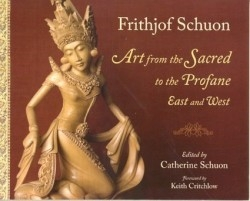Art from the Sacred to the Profane
East and West
“Traditional art derives from a creativity which combines heavenly inspiration with ethnic genius, and which does so in the manner of a science endowed with rules and not by way of individual improvisation.” So pronounces Swiss-born Frithjof Schuon (1907-1998), who authored more than twenty-five books about religion during his lifetime and was a painter and poet as well. In this collection of writings, he discusses sacred and profane art in traditional civilizations.
Schuon’s writings on art are so extensive that here his wife/editor Catherine Schuon organizes his work into logical chapters, such as “On Beauty and the Sense of the Sacred,” “Hindu Art,” and even “The Art of Dress and Ambience.” Apparently this was no easy task: she admits that since Schuon often wrote in the same paragraph about different arts, she sometimes extracted specific passages from several works. The editor is to be commended for picking relevant illustrations to bolster her husband’s ideas; in fact, much of the book’s appeal lies in her interesting selections. For example, one page is filled with a single primordial symbol that is found on such varying objects as a fifth-century Swedish picture stone, a fifteenth-century Nigerian wooden seat, an undated Ethiopian processional cross, and a seventh-century Irish book page.
What people need in order to find meaning in their lives, to discover earthly happiness, according to Schuon, are religion and the crafts. The editor illustrates this principle with images of people engaged in traditional crafts around the world, from an Apache basket maker to an Iranian carpet weaver. Schuon is quite emphatic about what constitute “the rights” of art, that is, its principles and criteria: the technical, spiritual, and intellectual qualities of the work.
Further, Schuon states, “True genius can develop without making innovations.” It follows that he dislikes non-traditional, or naturalistic art, finding it too individualistic. Included in this category are the classical arts of antiquity and art from the Renaissance through the nineteenth century. In short, he claims, “The least that one can say is that it is not this kind of grandeur that brings us closer to Heaven.”
Fans of art from these time periods might not be endeared to Schuon. Readers might also bristle at the author’s dated racist generalizations about, for example, “the yellow man” when he discusses Asian art. Putting these concerns aside, the book is useful for an in-depth study of comparative religious art. Even more, it beckons readers to return to short topics of special interest and to peruse the editor’s illustration choices. Whether or not readers agree with the author’s premises, his writings certainly provoke thought, resulting in a book that will be referred to repeatedly.
Disclosure: This article is not an endorsement, but a review. The publisher of this book provided free copies of the book to have their book reviewed by a professional reviewer. No fee was paid by the publisher for this review. Foreword Reviews only recommends books that we love. Foreword Magazine, Inc. is disclosing this in accordance with the Federal Trade Commission’s 16 CFR, Part 255.


